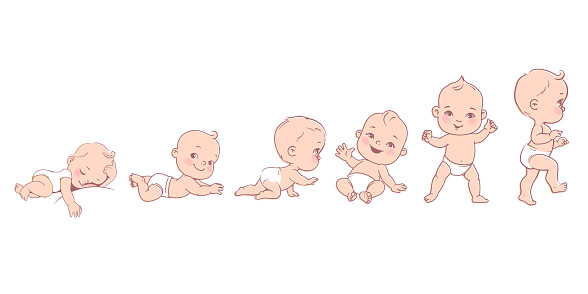
Infant development refers to the process of an orderly, continuous, phased, and gradual process from differentiation to complete psychological changes from the beginning of life, influenced by factors such as genetics, environment, and learning.
(1) The performance of infant development
1. Size changes
Physiological aspects: height, weight, and organs keep growing.
Psychological aspect: the ability of language vocabulary, memory, cognition, reasoning and social communication is continuously improved.
2. Proportion change
The physical and mental development of a baby has its own independent characteristics. It is not a shrinking adult, and its body proportions will change significantly during growth and development. For example, the head of the fetus accounts for 1/2 of the body length, the baby accounts for 1/4, and the adult accounts for 1/8.
3. The old features disappear
During the development of an individual, the old characteristics will disappear due to maturity, such as the loss of deciduous teeth in early childhood.
4. New feature acquisition
In the learning process, babies will gradually acquire some new abilities, such as curiosity, questioning, and physical permanent teeth.
(2) The task of infant development
In the process of growing up, babies need to have different performance behaviors in the social environment and find suitable roles in different hair stages, which need to complete the following "tasks".
(1) Learn to walk.
(2) Learn to eat solid foods.
(3) Learn to speak.
(4) Learn to control excretion function.
(5) Learn to recognize one's own organs and behaviors related to gender.
(6) Learn to interact with people and control emotions.
(7) Learn to judge right and wrong.
(8) Stable physiological functions.
(9) Form a simple concept of society and individual.
(3) The main characteristics of infant development
(1) The younger the age, the faster the growth rate. The growth rate of infancy is the fastest, but the growth rate is not a straight rise, but has a phased. For example, when the newborn is calculated in days, it is calculated in the unit of week when it is 1 to 3 months, it is calculated in the unit of 3 months when it is 4-6 months, and it is calculated in the unit of half a year when it is 6-12 months, 1- Calculated in years at the age of 3 years.
(2) The growth and development of infants have a certain order and direction, and they cannot leapfrog development. For example, the development of physical and motor skills in infancy follows the rule from head to toe.
(3) It is necessary to complete the transition from a natural person to a social person in the infancy, from a natural person without the ability to take care of themselves to a social person who can adapt to social life.
(4) Planning for infant age
UNICEF defines childhood as 0-18 years old. According to our country's living conditions and education, the development process from birth to maturity (0-18 years) is generally divided into six stages: infant, infancy, preschool, school age, juvenile and adolescence.
0-3 years old can be collectively referred to as infancy, or it can be subdivided into neonatal period (referring to 0-1 months), infant period (referring to 0-1 years old), and infant period (referring to 1-3 years old).
Each age of the baby has relatively stable and independent characteristics. For example, the neonatal period is mainly a period of adapting to outside life, which changes every day; the infant period is a period that requires more adult life care; and the infancy period is a period when they learn to walk, talk, and start independent activities.
